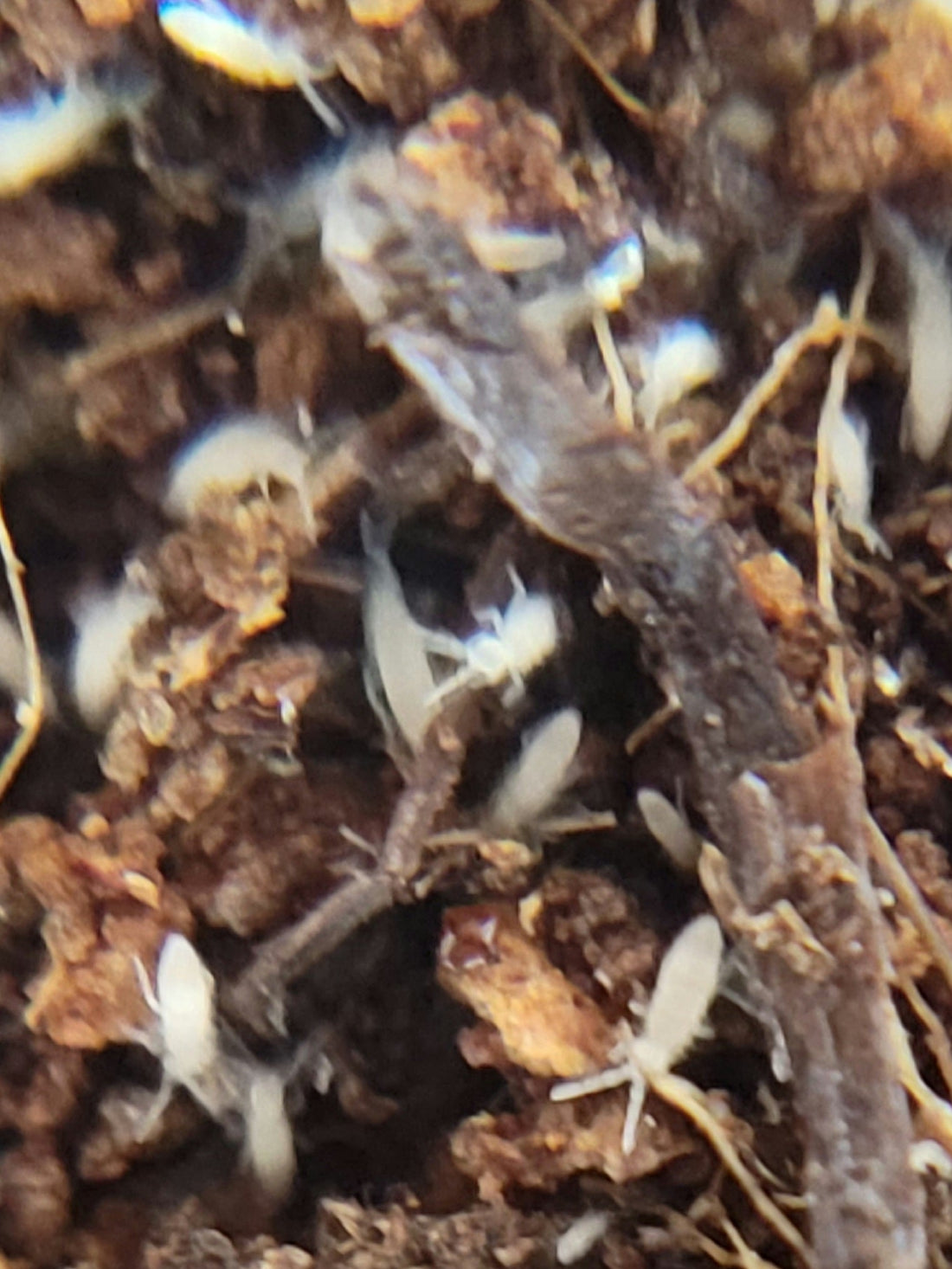For many years charcoal and soil were the substrates that were used for culturing the most common springtail in the hobby, Folsomia candida "Temperate." Clay is a newcomer as a media for culturing several types of springtails, but which of these three is the best? Well, the answer isn't black and white and simple, and a portion of the answer is whichever media is your personal preference.
Most of the common springtails currently available (unless they are aquatic springtails) do very well on soil. We keep all of our springtails on soil, and they produce extremely well, and the cultures last for years if they are maintained. Our oldest soil culture was started in 2012, and we maintain it by replacing a portion of the soil at least once a month and feeding small amounts of food twice weekly. We do not have ventilation holes in our cultures. Opening the culture twice a week to feed provides adequate air exchange for us. We've heard others say that soil cultures are prone to mites, but we 100% disagree. Overfeeding grain-based foods and keeping the cultures too wet or near other infested cultures encourages mites. We only feed active dry baking yeast to all of our springtails with the exception of Seira dowlingi, who love dried baby rice cereal, and Neanura growae thrive on fish food flakes. It is also a misconception that it's difficult to harvest springtails from soil. If you want to feed an animal springtails without the soil present, simply put a piece of damp charcoal on top of the soil. The springtails gather on it, and then you can easily grab the charcoal and tap or blow off the springtails to where you'd like them.
Charcoal is another option that became popular many years ago and one a lot of people are familiar with or see videos about, so they feel comfortable with it. Charcoal will work for Folsomia candida. I've never had success with other species of springtails. We've heard others say Coecobrya communis or tenbricosa survive on charcoal, but that has not been our experience. Charcoal is just too wet for most of the species commonly available. We recommend not buying a springtail culture on charcoal online because most, if not all, of the springtails will get crushed by the charcoal while being shipped. If you really want to try charcoal, make sure you purchase 100% natural hardwood lump charcoal and not briquettes. The briquettes are compressed and often have chemicals added. Rinse the charcoal well, and then add the springtails from either the clay culture or from the soil culture by placing a small piece of the charcoal on top of the soil for a short time until springtails gather on it and then place it in the charcoal culture.
Clay is the last springtail media that is commonly available. The clay is spread in a thin layer in a cup or container. People like clay because it can be easy to harvest from by simply tapping the springtails out, and there is the appearance that there are a lot of springtails in the cup because clay is mostly a flat surface so all of the springtails are visible. You must be very careful to not over water the clay culture because the clay will breakdown and mold. A few species will survive on clay such as Folsomia candida, Coecobrya tenebricosa/communis, Ceratophysella, Proistoma minuta, and probably several others that we do not personally have experience with.
We can explain our experiences more on why we personally chose soil. A lot of the springtails available are naturally found in soil and wood. The soil provides a lot of area for the springtails to tunnel and lay their eggs. It's easy to control the amount of moisture in the soil and provide areas of the container that are drier and others that are more damp. Our cultures are booming on soil. Springtails ship well on soil. If the shipping weather is too hot or too cold, the springtails can burrow in the soil and not freeze, nor get steamed, which happens with charcoal, clay, moss, or paper towel. It's easy to just put a scoop of soil containing springtails or dump the entire soil springtail cup into bioactive enclosures. If we need to "feed off" springtails to our dart frogs, we simply grab the piece of charcoal sitting on top of our cultures and tap it into the dart frog enclosure.
With charcoal, it's very limited on what springtails will survive on charcoal, and we never got the reproduction of springtails like we do on soil. Clay cultures have always molded over within a month or two for us, and the springtails don't produce as well for us on clay. Clay seems to give the appearance of a lot of springtails, but they are just gathered on the surface because there isn't a way for them to significantly tunnel throughout the clay.
Keep in mind that clay and charcoal may work superior for you depending on your climate. We live in a humid climate, so that's a factor that plays into what media brings us the most success. We recommend trying several methods to see which is the most successful for you. Over ten years we've experimented with different types of media including expanded clay pellets, lava rock, sphagnum moss, coco coir, and the list goes on. Those items were not the most successful for us personally, but there's nothing wrong with experimenting. Experimenting is part of this wonderful hobby!!



